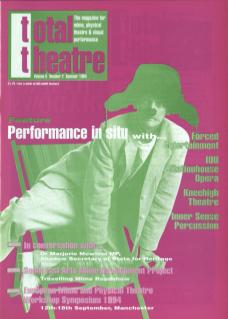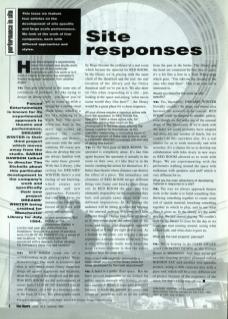Have the company's experiments away from black box studio work come out of any particular frustrations with this work or is it more a means to develop the company's theatre language/aesthetic from another angle?
TE: One gets very used to the same sets of conventions or problems. It's like trying to design an album cover – you know you've got to come up with a design for a certain sized blank space, which is a bit like working in a black box. The more often one does it, the more one comes up against the same problems, and desires, and reacts with the same solutions. Of course new ideas do develop but you are always familiar with the same basic ground. With the Library (the setting for Dreams’ Winter) there's a real feeling of not knowing, which creates new problems and new approaches. Formally that's the hook for us; for instance the library has forced us to work with sound and acoustics.
In your production Red Room at The Showroom Gallery in London last year you stated that the Installation ‘brought the action of previous work Club of No Regrets into a series of real locations’. Is Dreams’ Winter conceived with a desire to further develop the company's ideas in a real location?
TE: Red Room came out of a collaboration with photographer Hugo [Glendinning]. Our work in locations and sites is very much about flimsy theatrical things set against aggressive real locations, about the jarring of the theatrical and the real. With Red Room we did performances of scenes from Club of No Regrets in all sorts of places – in a lift on a housing estate, in the back of a car. The photographs taken by Hugo became the evidence of a real event which became the material for Red Room. In the library we're playing with the same clash of the theatrical and the real, the real location of the library and the flimsy theatrical stuff we've put in it. We also draw on film when responding to a site – just looking at the space and asking ‘what movie scene would they film here?’ – the library would be a great place for a chase sequence.
All your shows require a vigorous active role from the spectator. In Red Room the spectator takes a more active role, for example, shining their torch on the photographs in the first room, piecing the events together for themselves. Is this spectator relationship a motivating factor in the development of these new projects, and is Dreams’ Winter conceived with the idea of taking this further?
TE: In the first part of Red Room, the spectator is completely alone. It's like film again because the spectator is actually in the room on their own, it's like they're in the movie, creating the action for themselves. It's better than theatre where distance can destroy the effect of a piece. The immediacy and closeness of Red Room moves different things into frame and knocks other things out. In Red Room the spectator was ultimately responsible for the experience they had, and people came away with very different impressions. In the library the audience will be sitting at tables but because of the unusual acoustic everyone will hear different things. Things said close up sound as if they come from the other side of the room, and things said diagonally opposite you sound as if they are right next to you. As a listener to the piece, you will get a unique experience, a unique relation to the text. This is very different to studio work where the most certain element is that the entire audience hear the same text. This project was originally planned for a hotel.
Once you found the library were the ideas developed for the hotel abandoned?
TE: A hotel is a public fluid space. But the hotel proved impossible so we looked for public spaces through which many people have moved. A library is especially evocative because it holds the present presences and voices of people as well as all the voices from the past in the books. The library and the hotel are connected by this idea of pasts, it's a bit like a line in a Tom Waits song which goes, ‘You take on the dreams of the ones who slept there’. This is an idea we're interested in.
Would you describe the work as site-specific?
TE: Yes, incredibly. Dreams’ Winter literally couldn't be done anywhere else because the acoustic is so crucial. Red Room could be adapted to another gallery, even though we did make use of the unusual shape of The Showroom. If we'd stuck with the hotel we could probably have adapted that piece for any number of hotels, but we couldn't do this anywhere else. It's a real chance for us to work musically and with acoustics. It's a chance for us to develop our collaboration with John Avery in new ways as Red Room allowed us to work with Hugo. We are experimenting with the performers walking around the space with walkmans with speakers and stuff which is very different for us.
What are the main attractions of developing material in response to a site?
TE: The way we always approach theatre work in the studio is to build something first; throwing something together to create some sort of spatial material: knocking something together in which to play, and to see what clues it gives us. In the library it's the same process. We just started playing. We couldn't wait for the library to close for the day so we could just start running around, seeing what looked right, and what clues it gave us.
What are the next projects planned?
TE: We're hoping to do 12am Awake and Looking Down at the Corner House in Manchester. And then we've got another touring project planned called Hidden Jay and another site-specific project, using a 40ft concrete box with a glass roof, which will be a very different sort of project because of the emptiness of the space, but that's a long way off yet.
Dreams' Winter will be performed at Manchester Central Library on the 15th, 16th 18th & 10th July at 9pm.

